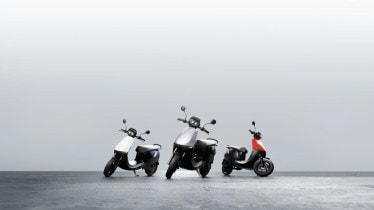Despite the partial withdrawal of Centre-sponsored subsidy from April, Ola Electric has been able to ramp up its sales and marketshare during the month. In fact, its market share during April is at an all-time high. The company has been able to do so by not passing on the price hike to customers unlike its peers like TVS, Bajaj, and Ather, all of whom have seen decline in sales and market share post the subsidy withdrawal.
In April, the Bengaluru-based start-up chipped away market shares of its rivals TVS Motor Company, Ather Energy and Bajaj Auto to emerge unscathed by the demand disruption caused by the withdrawal of the incentives.
Ola pushed its market share to 52% in April with volumes of nearly 34,000 units, as per vehicle registration data supplied by Vahan and ICICI Securities. This volume total is at the same level as January and February despite the incentive withdrawal.
TVS and Bajaj closed the same month with 12% share each at 7,653 units and 7,515 units. Ather’s share nearly halved to 6% with 4,052 units and was the worst performer during the same month.
Market watchers point out three critical reasons behind the jump in market share and a steady monthly volume.
“Ola has hardly taken a price hike post the FAME reduction, compared to Rs 5,000-15,000 range by Ather. TVS, whose vehicles are quite pricey compared to OLA, hasn’t taken much price hike but has still lost market share,” said Yogesh Aggarwal, head of research, HSBC Securities and Capital Markets.
The report further states that Ola’s distribution is better than competition. “In some states like Uttar Pradesh, Bihar, Rajasthan and Gujarat, where incumbents like Bajaj and TVS may not be aggressively distributing their EVs, OLA has higher market share,” the HSBC report added.
Lastly, Ola brought down its product entry price to Rs 70,000 from Rs 89,000 making it cheaper than the Honda Activa, India’s largest selling petrol-powered scooter. This has allowed Ola to chase buyers who considered e2Ws to be out of reach. None of the other e2W players have offerings priced below Rs 1 lakh.
On April 1, the government rolled out the Electric Mobility Promotion Scheme (EMPS), where the subsidy per e2W was halved to Rs 5,000/kWh from Rs 10,000/kWh and capped to a maximum of Rs 10,000 per vehicle. This new scheme replaced the previous subsidy scheme titled FAME-2 (Faster Adoption and Manufacturing of Electric Vehicles).
Bajaj Auto, which is the third largest e2W maker, is ready to jump into the mass market segment under the Chetak brand. In the ongoing June quarter, the Pune-based company will add one to two cheaper derivatives of the Chetak. The company, however, has not provided price indications.
“This will give us a larger play in the mass segment. It will be better priced and hopefully give us far more traction,” Sharma added. Presently, the cheapest Chetak is priced at Rs 123,300.
Electric two-wheeler market grew by 30% in FY24 to 947,087 units as against 728,205 units clocked in FY23, as per data shared by the Federation of Automobile Dealers Association. Growth is expected to taper in FY25 following the reduction in subsidies.
